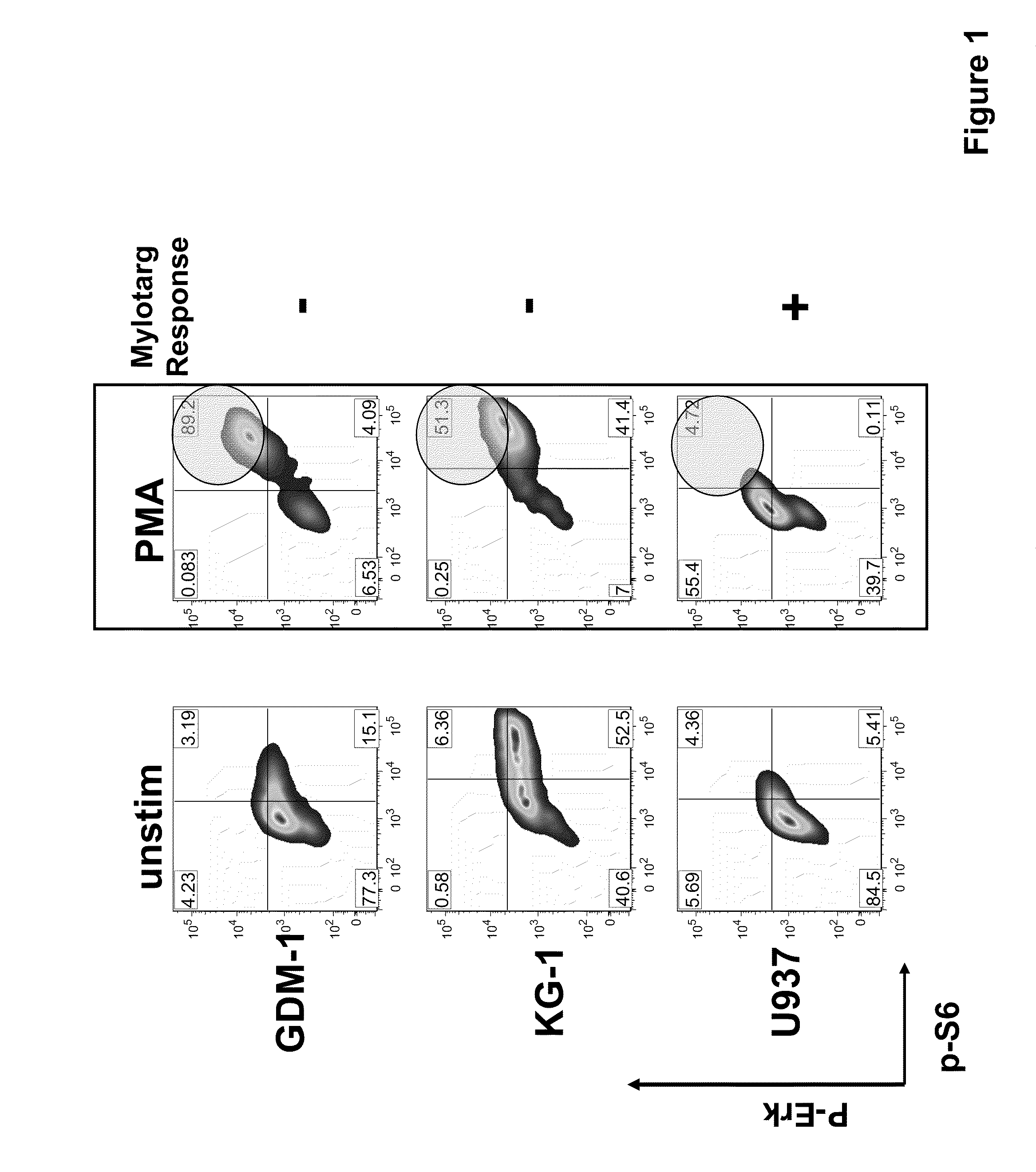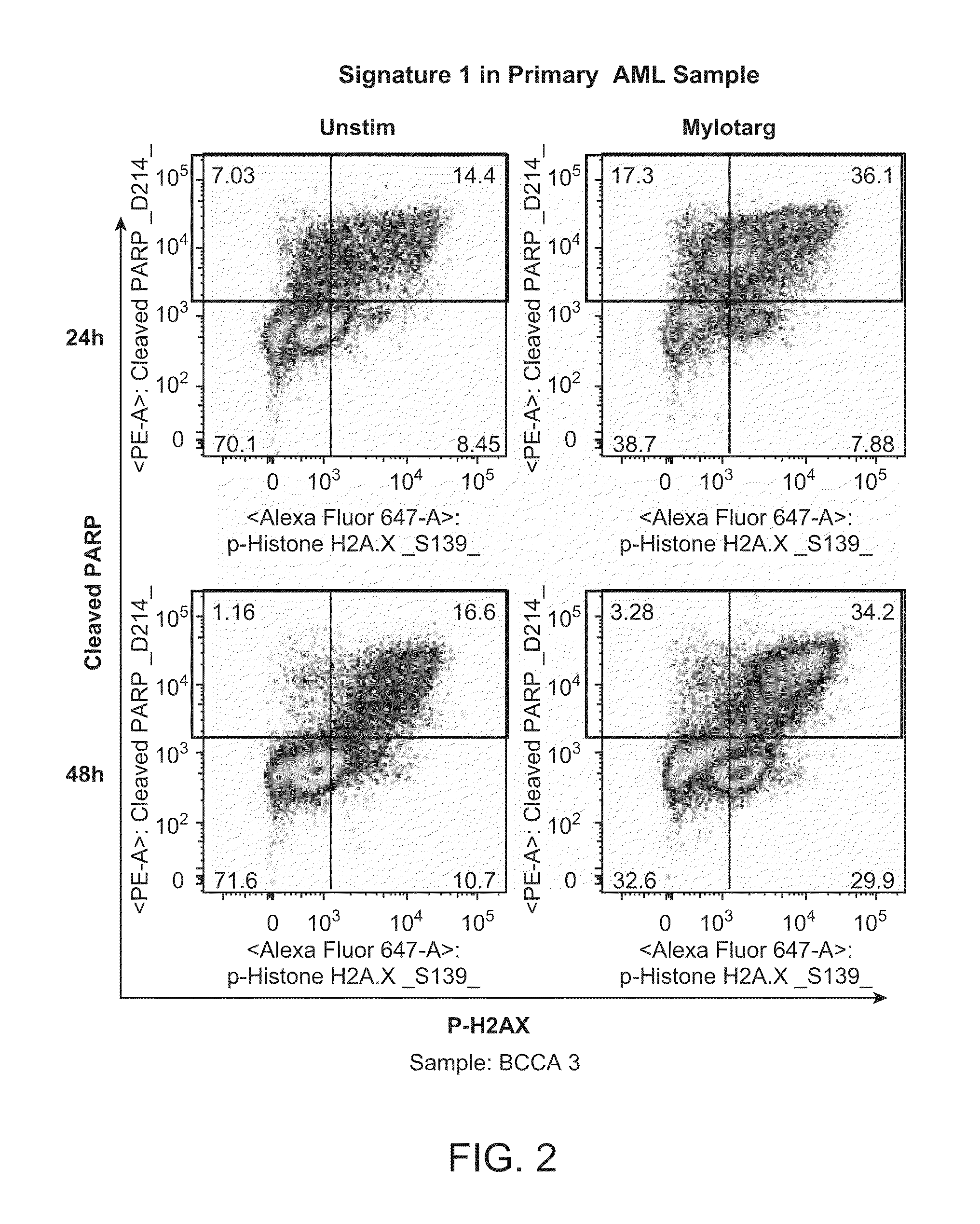Methods for Analyzing Drug Response
a drug response and drug technology, applied in the field of methods for analyzing drug responses, can solve problems such as increased cell survival and uncontrolled growth
- Summary
- Abstract
- Description
- Claims
- Application Information
AI Technical Summary
Benefits of technology
Problems solved by technology
Method used
Image
Examples
example 1
Materials and Methods
[0288]The present illustrative example represents how to analyze cells in one embodiment of the present invention. There are several steps in the process, such as treatment with modulator, incubation with antibodies, and processing sample for acquisition of cells on the cytometer. Treatment with modulator(s) can start with thawed cryopreserved cells and end with cells fixed in PFA and permeabilized in methanol. Then the cells can be incubated with an antibody directed to a particular protein of interest and then analyzed using a flow cytometer. A protocol similar to the following was used to analyze AML cells from patient samples. The materials and methods described in this example can be used and / or were used in the other examples described below.
[0289]Materials: In this example, the following materials are used: Phosphate Buffered Saline (PBS) (MediaTech); Thawing media (PBS-CMF+10% FBS+2 mM EDTA); 70 um Cell Strainer (BD); 1 uL anti-CD45 Alexa 700 (Invtrogen)...
example 2
Profile for Mylotarg Resistance
[0296]Mvlotarg: Gemtuzumab ozogamicin (G0), a humanized IgG4 anti-CD33 monoclonal antibody conjugated to n-acetyl-γ-calicheamicin dimethyl hydrazide, is indicated for the treatment of patients with CD33 positive AML in first relapse who are 60 years or older and who are not considered candidates for cytotoxic therapy (Bross et al., Clin. Can. Research (2001) 7:1490-1496, Sievers et al., J. Clin. One. (2001) 19:3244). Many individual steps make-up Mylotarg's mechanism of action (MOA) including but not limited to binding of the monoclonal antibody component of the drug conjugate to the CD33 antigen expressed by leukemic cells, followed by cellular internalization, hydrolytic release of calicheamicin, DNA damage and eventual cell apoptosis. Key parameters involved in Mylotarg's MOA are: CD33 expression, drug transporter function, drug transporter expression, internalization mechanisms for the drug Mylotarg, intracellular hydrolysis (pH change), redox pote...
example 3
Effects of Mylotarg exposure
[0359]In the following example, several observations were made regarding determinations of cell death and cell cycle, determinations of DNA damage and apoptosis, determinations of modulated intracellular signaling pathways mediated by agents including cytokines or growth factors upon Mylotarg exposure. The data is generated from cancer cell lines GDM-1, KG-1 (myeloid leukemic cell lines), and Ramos (a B cell lymphoma cell line (See U.S. Provisional Application No. 61 / 186,619) which are identified as Mylotarg refractory, and U937, which is identified as Mylotarg sensitive.
[0360]The experimental measurements included forward and side scatter, the use of viability dyes (amine aqua and propidium iodide (PI)), and determination of cell cycle and apoptosis by measuring DNA content with DRAQ5. Additionally, cell cycle progression was measured by determining levels of cyclin B1, phosphorylated histone H3, and phosphorylated CDK-1. All these determinations were ma...
PUM
| Property | Measurement | Unit |
|---|---|---|
| molecular weight | aaaaa | aaaaa |
| pore sizes | aaaaa | aaaaa |
| temperature | aaaaa | aaaaa |
Abstract
Description
Claims
Application Information
 Login to View More
Login to View More - R&D
- Intellectual Property
- Life Sciences
- Materials
- Tech Scout
- Unparalleled Data Quality
- Higher Quality Content
- 60% Fewer Hallucinations
Browse by: Latest US Patents, China's latest patents, Technical Efficacy Thesaurus, Application Domain, Technology Topic, Popular Technical Reports.
© 2025 PatSnap. All rights reserved.Legal|Privacy policy|Modern Slavery Act Transparency Statement|Sitemap|About US| Contact US: help@patsnap.com



